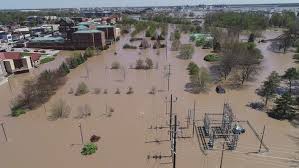 Flooding in downtown Midland, MI. Photo courtesy of the City of Midland, MIAs reported by the Washington Post.
Flooding in downtown Midland, MI. Photo courtesy of the City of Midland, MIAs reported by the Washington Post.
Fortunately, the Midland commercial nuclear power plant was never fired up, so there is no radioactive contamination there, nor high-level radioactive waste in on-site storage.
Dr. Mary Sinclair, a co-founder and co-leader of Don't Waste Michigan*, helped lead the successful resistance to the Midland nuclear power plant, way back in the 1970s and 1980s.
The reason the Midland nuclear power plant was stopped, at 90% construction completion on one reactor and about 50% on the other, was that safety-significant buildings were sinking into the ground, not unlike the Leaning Tower of Pisa. Of course, it took many years of dedicated commitment and hard work by anti-nuclear activists, talented environmental attorneys, and even a courageous Nuclear Regulatory Commission (NRC) whistle-blower testifying before Congress, to prevail against greed-driven companies like Midland-based Dow Chemical, and Jackson, MI-based Consumers Energy.
Speaking of Dow, there is, however, a 1967-era research reactor at its Midland facilities, that is potentially in harm's way from the flooding, as we speak (See NRC Event Notification Report, May 20, 2020, Event Number 54719) . And there is, of course, off the charts bad dioxin and other toxic chemical contamination in or near these waterways, compliments of Dow. This includes a Superfund site, severe contamination downstream in the Tittabawassee River, as well as wastewater retention ponds at Dow Chemical itself. Groups like Citizens for Alternatives to Chemical Contamination (CACC)*, Lone Tree Council, and others, have for decades watch-dogged the toxic goings-on at and downstream from Dow.
Mary Sinclair's son, Peter Sinclair, a climate protection leader, is quoted in the Washington Post article linked above. Here are some passages from the article, including Peter Sinclair's quote:
Dow Chemical Co.’s Midland headquarters was evacuated, with only essential staff remaining on-site to monitor the situation. The facility is associated with a Superfund site due to excess dioxins, which are known to cause cancer, in the riverbed downstream of the plant. New video released by the Michigan State Police appeared to show some flooding on the Dow property, though the extent and severity is unclear.
“Dow has activated its local emergency operations center and is implementing its flood preparedness plan which includes the safe shutdown of operating units,” wrote the company on its Facebook page. Dow also filed an “Unusual Event Report” with the Nuclear Regulatory Commission because of the possibility that floodwaters could affect its 300 kilowatt nuclear research reactor, located at the plant, though the reactor was already shut down due to the coronavirus outbreak. That reactor was built in 1967.
“This is a solidly middle to upper class town because of the Dow plant here,” Peter Sinclair, a Midland resident who is a videographer for Yale Climate Connections, said in an interview. He said a 2017 seasonal flood event, combined with this disaster, may cause property values to decline. This includes expensive lakefront property, since these lakes are now being drained by the flooding.
...Sinclair, who is on the dry side of Midland and is sheltering family members who live closer to the flood-affected areas, says this event illustrates what climate scientists have been warning about for years.
“[There is the] Larger issue of aging infrastructure plus incremental climate change, this is a point that all the scientists make that the change is gradual, gradual, gradual until the infrastructure fails.”
While this catastrophic flooding is very bad enough in its own right, it also raises the specter of worsening flooding impacts on nuclear facilities,
in the Great Lakes Basin and across the continent, including the worsening high risk of dam bursts upstream of nuclear facilities.
The July 16, 1979 uranium tailings dam burst in n.w. New Mexico, inundating the Rio Puerco with a flood of radioactive and toxic wastewater, is considered one of the single worst nuclear disasters in U.S. history (that most people have never even heard of). Navajo/Diné shepherds live downstream, such as in the Red Water Pond Road Community. The Rio Puerco is their sole source of drinking and irrigation water. The shallowest of "clean ups" was carried out, leaving most of the escaped contamination in the environment.
The mass evacuation of 10,000 Michiganders to escape the floodwaters, amidst global pandemic stay-at-home and social-distancing orders, also raises the specter of a radiological disaster requiring mass evacuation at a time like this. The NRC, FEMA, related state government agencies across the country, and the nuclear power industry itself, have not addressed this question and concern. How are people supposed to shelter at home, and maintain physical distance from others, when forced to flee for their health and lives, whether from floodwaters as in Midland, or from hazardous radioctivity if a nuclear diaster were to occur during this pandemic emergency.
David Lochbaum, retired from UCS, raised just such questions recently in the Bulletin of the Atomic Scientists, when a tornado struck his hometown of Chattanooga, TN, amidst the pandemic; Chattanooga "hosts" multiple atomic reactors in the area.
Dr. Mary Sinclair herself presciently warned about the high risks of storing high-level radioactive waste on the shores of the Great Lakes and the banks of major rivers -- the fresh drinking water sources for both Canada and the U.S. -- as well as along the ocean coasts (also experiencing climate change-induced sea level rise). She did this in a mid- to late-1990s presentation she delivered on public access television in her area.
*Kevin Kamps, Beyond Nuclear's radioactive waste specialist, serves on Don't Waste Michigan's board of directors, and on Citizens for Alternatives to Chemical Contamination's advisory board.
Update on May 22, 2020 by
 admin
admin





 September 20, 2021
September 20, 2021

